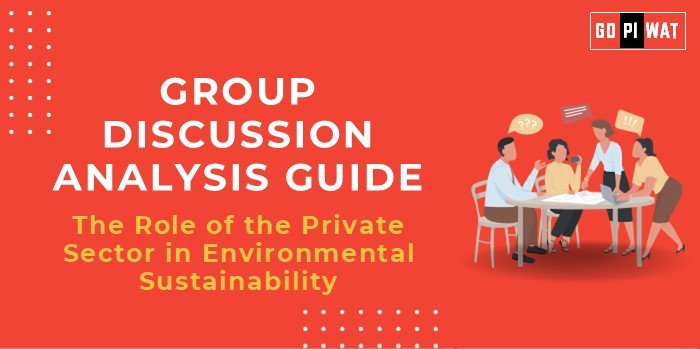📋 GD Analysis Guide: The Role of the Private Sector in Environmental Sustainability
🌐 Introduction to the Role of the Private Sector in Environmental Sustainability
🔍 Context: As environmental concerns intensify globally, the private sector faces increasing pressure to adopt sustainable practices. In the transition toward sustainable economies, companies play a critical role, impacting resource use, carbon emissions, and waste management.
💡 Background: Private sector involvement in environmental sustainability began as part of corporate social responsibility but has evolved. Many companies now integrate sustainability as a strategic business function, aligning with regulatory standards and consumer demand for green practices.
📊 Quick Facts and Key Statistics
- 🌍 Global Green Investment: Private sector investments in green technologies reached $1.1 trillion in 2022, showing substantial commitment to sustainability.
- 🌿 Corporate Emission Reductions: Approximately 45% of the world’s largest companies have set targets to achieve net-zero carbon emissions by 2050.
- ♻️ Waste Reduction Efforts: Companies in the U.S. and Europe have reduced plastic waste by up to 20% annually through sustainable packaging.
- 🔋 Renewable Energy Use: Nearly 60% of multinational corporations plan to increase their use of renewable energy by 2030.
- 📈 Impact on GDP: Green investments contribute to economic growth, with sustainable sectors growing at twice the rate of conventional sectors.
🤝 Stakeholders and Their Roles
- 🏢 Private Companies: Implement eco-friendly policies, invest in green technologies, and reduce emissions.
- 🏛️ Governments and Regulators: Establish guidelines, provide incentives, and enforce penalties for non-compliance.
- 🌱 NGOs and Environmental Groups: Advocate for stricter environmental standards and educate the public.
- 🛍️ Consumers: Drive demand for sustainable products and hold companies accountable.
🌟 Achievements and Challenges
🏆 Achievements
- 🌍 Reduced Carbon Emissions: Initiatives from companies like Microsoft and Tesla illustrate how technology and innovation can cut emissions.
- 🛒 Sustainable Product Innovations: Firms in consumer goods, such as Unilever, lead in producing eco-friendly products.
- ♻️ Waste Management Initiatives: Companies in the fashion industry, such as Patagonia, have developed circular models to reduce waste.
⚠️ Challenges
- 🌐 Regulatory Variability: Standards differ across countries, complicating compliance for multinational corporations.
- 💸 Short-Term Profit Focus: Sustainability initiatives often require substantial upfront investment, conflicting with short-term profit goals.
🌍 Global Comparisons
Japan demonstrates strong private sector-government partnerships for renewable energy, while Germany leads in waste management through comprehensive recycling programs.
🗣️ Structured Arguments for Discussion
- ✅ Supporting Stance: “The private sector plays a pivotal role in driving sustainability, as corporate innovations lead to significant environmental gains.”
- ❌ Opposing Stance: “Private sector efforts alone are insufficient, as profit motives often compromise long-term environmental goals.”
- 🤔 Balanced Perspective: “While the private sector contributes meaningfully, its impact is most effective when complemented by robust regulations and consumer demand.”
💡 Effective Discussion Approaches
- 📊 Opening Approaches:
- 📈 Statistical Impact: “With green investments surpassing $1 trillion, the private sector’s role in sustainability is no longer optional.”
- 📖 Case Study: “Germany’s circular economy demonstrates the potential of private initiatives in achieving near-zero waste goals.”
- 💬 Counter-Argument Handling:
- Highlight data that shows success where regulation and private investment align, such as renewable energy use by tech giants in regulated markets.
📋 Strategic Analysis of Strengths and Weaknesses
- 💪 Strengths: Innovation in technology, access to capital, capacity for large-scale impact.
- 🚧 Weaknesses: Dependence on regulation, profit-driven focus, lack of standardization.
- 🌱 Opportunities: Global leadership in sustainable products, green technology development.
- ⚠️ Threats: Climate change costs, public backlash for greenwashing.
🎓 Connecting with B-School Applications
- 🌍 Real-World Applications: Sustainability in supply chain management, corporate finance for green investments, eco-marketing strategies.
- 📋 Sample Interview Questions:
- “What role should profit play in a company’s sustainability strategy?”
- “How can businesses balance environmental goals with financial ones?”
- 💡 Insights for B-School Students: Explore sustainable business models, understand regulatory impacts, and examine eco-friendly consumer trends.


